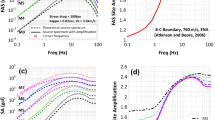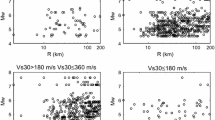Abstract
An important parameter for the characterization of strong ground motion at high-frequencies (>1 Hz) is kappa, κ, which models a linear decay of the acceleration spectrum, a(f), in log-linear space (i.e. a(f) = A 0 exp(− π κ f) for f > f E where f is frequency, f E is a low frequency limit and A 0 controls the amplitude of the spectrum). κ is a key input parameter in the stochastic method for the simulation of strong ground motion, which is particularly useful for areas with insufficient strong-motion data to enable the derivation of robust empirical ground motion prediction equations, such as mainland France. Numerous studies using strong-motion data from western North America (WNA) (an active tectonic region where surface rock is predominantly soft) and eastern North America (ENA) (a stable continental region where surface rock is predominantly very hard) have demonstrated that κ varies with region and surface geology, with WNA rock sites having a κ of about 0.04 s and ENA rock sites having a κ of about 0.006 s. Lower κs are one reason why high-frequency strong ground motions in stable regions are generally higher than in active regions for the same magnitude and distance. Few, if any, estimates of κs for French sites have been published. Therefore, the purpose of this study is to estimate κ using data recorded by the French national strong-motion network (RAP) for various sites in different regions of mainland France. For each record, a value of κ is estimated by following the procedure developed by Anderson and Hough (Bull Seismol Soc Am 74:1969–1993, 1984): this method is based on the analysis of the S-wave spectrum, which has to be performed manually, thus leading to some uncertainties. For the three French regions where most records are available (the Pyrenees, the Alps and the Côtes-d’Azur), a regional κ model is developed using weighted regression on the local geology (soil or rock) and source-to-site distance. It is found that the studied regions have a mean κ between the values found for WNA and ENA. For example, for the Alps region a κ value of 0.0254 s is found for rock sites, an estimate reasonably consistent with previous studies.








Similar content being viewed by others
References
Anderson, J. G. and Hough, S. E. (1984), A model for the shape of the Fourier amplitude spectrum of acceleration at high frequencies, Bull. Seismol. Soc. Am. 74(5), 1969–1993
Atkinson, G. M. (2008), Ground-motion prediction equations for eastern North America from a referenced empirical approach: Implications for epistemic uncertainty, Bull. Seismol. Soc. Am. 98(3), 1304–1318. doi:10.1785/0120070199.
Atkinson, G. M. and Boore, D. M. (2006), Earthquake ground-motion prediction equations for eastern North America. Bull. Seismol. Soc. Am. 96(6), 2181–2205. doi:10.1785/0120050245.
Baumont, D. and Scotti, O. On the impact of the binning strategy on macroseismic magnitude-depth-I 0 estimates. In Proceedings of First European Conference on Earthquake Engineering and Seismology (a joint event of the 13th ECEE & 30th General Assembly of the ESC), Sep 2006. Abstract CS2-625.
Bay, F., Fäh, D., Malagnini, L. and Giardini, D. (2003), Spectral shear-wave ground-motion scaling in Switzerland, Bull. Seismol. Soc. Am. 93(1), 414–429.
Bay, F., Wiemer, S., Fäh, D. and Giardini, D. (2005), Predictive ground motion scaling in Switzerland: Best estimates and uncertainties. J. Seismol. 9, 223–240.
Bommer, J. J., Stafford, P. J., Alarcón, J. E. and Akkar, S. (2007), The influence of magnitude range on empirical ground-motion prediction, Bull. Seismol. Soc. Am. 97(6), 2152–2170. doi:10.1785/0120070081.
Boore, D. M. SMSIM—Fortran programs for simulating ground motions from earthquakes: Version 2.3—A revision of OFR 96-80-A. Open-File Report 00-509, United States Geological Survey, Aug 2005. Modified version, describing the program as of 15 August 2005 (Version 2.30).
Campbell, K. W. (2003), Prediction of strong ground motion using the hybrid empirical method and its use in the development of ground-motion (attenuation) relations in eastern North America, Bull. Seismol. Soc. Am. 93(3), 1012–1033.
Campillo, M., Plantet, J. -L. and Bouchon, M. (1985), Frequency-dependent attenuation in the crust beneath central France from Lg waves: Data analysis and numerical modeling, Bull. Seismol. Soc. Am. 75(5), 1395–1411.
Campillo, M., Feignier, B., Bouchon, M. and Béthoux, N. (1993), Attenuation of crustal waves across the Alpine Range, J. Geophys. Res. 98(B2), 1987–1996.
Cotton, F., Scherbaum, F., Bommer, J. J. and Bungum, H. (2006), Criteria for selecting and adjusting ground-motion models for specific target regions: Application to central Europe and rock sites, J. Seismol. 10(2), 137–156. doi:10.1007/s10950-005-9006-7.
Cotton, F., Pousse, G., Bonilla, F., and Scherbaum F. (2008), On the discrepancy of recent European ground-motion observations and predictions from empirical models: Analysis of KiK-net accelerometric data and point-sources stochastic simulations, Bull. Seismol. Soc. Am. 98(5), 2244–2261. doi:10.1785/0120060084.
Douglas, J., Bungum, H. and Scherbaum, F. (2006), Ground-motion prediction equations for southern Spain and southern Norway obtained using the composite model perspective, J. Earthq. Eng. 10(1), 33–72.
Douglas, J., Gehl, P., Bonilla, L. B., Scotti, O., Régnier, J., Duval, A. -M. and Bertrand, E. (2009), Making the most of available site information for empirical ground-motion prediction, Bull. Seismol. Soc. Am. 99(3), 1502–1520. doi:10.1785/0120080075.
Draper, N. R. and Smith, H. (1998), Applied regression analysis. (3rd edn. Wiley, New York).
Drouet, S., Souriau, A. and Cotton, F. (2005), Attenuation, seismic moments, and site effects for weak-motion events: Application to the Pyrenees. Bull. Seismol. Soc. Am. 95(5), 1731–1748. doi:10.1785/0120040105.
Drouet, S., Chevrot, S., Cotton, F. and Souriau, A. (2008), Simultaneous inversion of source spectra, attenuation parameters, and site responses: Application to the data of the French Accelerometric Network, Bull. Seismol. Soc. Am. 98(1), 198–219. doi:10.1785/0120060215.
Hough S.E., Anderson J.G. (1988) High-frequency spectra observed at Anza, California: Implications for Q structure. Bulletin of the Seismological Society of America, 78(2):692–707
Hough, S. E., Anderson, J. G., Brune, J., Vernon, III F., Berger, J., Fletcher, J., Haar, L., Hanks, T. and Baker, L. (1988), Attenuation near Anza, California, Bull. Seismol. Soc. Am. 78(2), 672–691.
Konno, K. and Ohmachi, T. (1998), Ground-motion characteristics estimated from spectral ratio between horizontal and vertical components of microtremor, Bull. Seismol. Soc. Am. 88(1), 228–241.
Malagnini, L., Herrmann, R. B. and Koch, K. (2000), Regional ground-motion scaling in central Europe, Bull. Seismol. Soc. Am. 90(4), 1052–1061.
Margaris, B. N. and Boore, D. M. (1998), Determination of Δσ and κ 0 from response spectra of large earthquakes in Greece. Bull. Seismol. Soc. Am. 88(1), 170–182.
Morasca, P., Malagnini, L., Akinci, A., Spallarossa, D. and Herrmann, R. B. (2006), Ground-motion scaling in the western Alps, J. Seismol. 10(3), 315–333. doi:10.1007/s10950-006-9019-x.
Papageorgiou, A. S. and Aki, K. (1983), A specific barrier model for the quantitative description of inhomogeneous faulting and the prediction of strong ground motion. Part I. Description of the model, Bull. Seismol. Soc. Am. 73(3), 693–702
Parolai, S. and Bindi, D. (2004), Influence of soil-layer properties on κ evaluation, Bull. Seismol. Soc. Am. 94(1), 349–356.
Péquegnat, C., Guéguen, P., Hatzfeld, D. and Langlais, M. (2008), The French Accelerometric Network (RAP) and National Data Centre (RAP-NDC), Seismol. Res. Lett. 79(1), 79–89.
Silva, W., Darragh, R., Gregor, N., Martin, G., Abrahamson, N. and Kircher, C. (1998), Reassessment of site coefficients and near-fault factors for building code provisions. Technical Report Program Element II: 98-HQ-GR-1010, Pacific Engineering and Analysis, El Cerrito, USA
Tsai, C-C. P. and Chen, K. -C. (2000), A model for the high-cut process of strong-motion accelerations in terms of distance, magnitude, and site condition: An example from the SMART 1 array, Lotung, Taiwan, Bull. Seismol. Soc. Am. 90(6), 1535–1542.
Acknowledgments
This study was funded by BRGM research and public service projects and a grant from the Réseau Accélérometrique Permanent (RAP) of France. The strong-motion networks in France are operated by various organizations (see the RAP website), under the aegis of the RAP. The RAP data centre is based at Laboratoire de Géophysique Interne et de Tectonophysique, Grenoble. We are very grateful to the personnel of these organizations for operating the stations and providing us with the data, without which this study would have been impossible. Finally, we thank Stéphane Drouet, Glenn Biasi and David Boore for careful and detailed reviews of earlier versions of this article and Stéphane Drouet for his GMT script to draw maps of epicentral and station locations and travel paths.
Author information
Authors and Affiliations
Corresponding author
Additional information
John Douglas is currently on teaching leave at Earthquake Engineering Research Centre, University of Iceland, Austurvegur 2A, 800 Selfoss, Iceland.
Rights and permissions
About this article
Cite this article
Douglas, J., Gehl, P., Bonilla, L.F. et al. A κ Model for Mainland France. Pure Appl. Geophys. 167, 1303–1315 (2010). https://doi.org/10.1007/s00024-010-0146-5
Received:
Revised:
Accepted:
Published:
Issue Date:
DOI: https://doi.org/10.1007/s00024-010-0146-5




